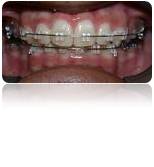What is an orthodontist?
An orthodontist is a specialist who has completed an advanced education program following dental school to learn the special skills required to manage tooth movement and guide facial development.
What are some possible benefits of orthodontics?
- Reduced appearance-consciousness
- Better function of the teeth
- Possible increase in self-confidence
- Increased ability to clean the teeth
- Improved force distribution and wear patterns of the teeth
- Better long-term health of teeth and gums
- Guide permanent teeth into more favorable position
- Reduce the risk of injury to protruded front teeth
- Aids in optimizing other dental treatment
How does orthodontic treatment work?
Braces use steady gentle pressure to gradually move teeth into their proper positions. The brackets that are placed on your teeth and the archwire that connects them are the main components. When the archwire is placed into the brackets, it tries to return to its original shape. As it does so, it applies pressure to move your teeth to their new, more ideal positions.
Would an adult patient benefit from orthodontics?
Orthodontic treatment can be successful at any age. Everyone wants a beautiful and healthy smile. Twenty to twenty-five percent of orthodontic patients today are adults.
What are some signs that braces may be needed?
- Upper front teeth protrude excessively over the lower teeth, or are bucked
- Upper front teeth cover the majority of the lower teeth when biting together (deep bite)
- Upper front teeth are behind or inside the lower front teeth (underbite)
- The upper and lower front teeth do not touch when biting together (open bite)
- Crowded or overlapped teeth
- The center of the upper and lower teeth do not line up
- Finger- or thumb-sucking habits which continue after six or seven years old
- Teeth wearing unevenly or excessively
- The lower jaw shifts to one side or the other when biting together
At what age should orthodontic treatment occur?
Orthodontic treatment can be started at any age. Many orthodontic problems are easier to correct if detected at an early age before jaw growth has slowed. Early treatment may mean that a patient can avoid surgery and more serious complications. The American Association of Orthodontists recommends that every child first visit an orthodontist by age 7 or earlier if a problem is detected by parents, the family dentist, or the child's physician.
What is Phase I and Phase II treatment?
Phase I, or early interceptive treatment, is limited orthodontic treatment (e.g. expander or partial braces) before all of the permanent teeth have erupted. Such treatment can occur between the ages of six and ten. This treatment is sometimes recommended to make more space for developing teeth, correction of crossbites, overbites, and underbites, or harmful oral habits. Phase II treatment is also called comprehensive treatment because it involves full braces when all of the permanent teeth have erupted, usually between the ages of eleven and thirteen.
Overview
How long does orthodontic treatment take?
Treatment times vary on a case-by-case basis, but the average time is from one to two years. Actual treatment time can be affected by rate of growth and severity of the correction necessary. Treatment length is also dependent upon patient compliance. Maintaining good oral hygiene and keeping regular appointments are important in keeping treatment time on schedule.
Do braces hurt?
The placement of bands and brackets on your teeth does not hurt. Once your braces are placed and connected with the archwires you may feel some soreness of your teeth for one to four days. Your lips and cheeks may need one to two weeks to get used to the braces on your teeth.
Will braces interfere with playing sports?
No. It is recommended, however, that patients protect their smiles by wearing a mouthguard when participating in any sporting activity. Mouthguards are inexpensive, comfortable, and come in a variety of colors and patterns.
Will braces interfere with playing musical instruments?
No. However, there may be an initial period of adjustment. In addition, brace covers can be provided to prevent discomfort.
Should I see my general dentist while I have braces?
Yes, you should continue to see your general dentist every six months for cleanings and dental checkups.
